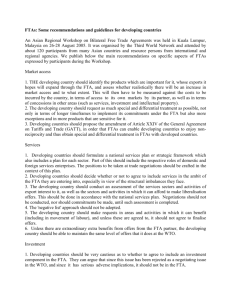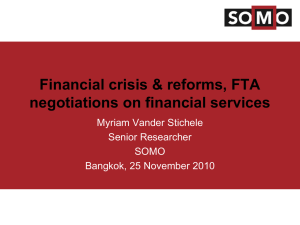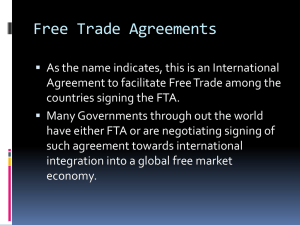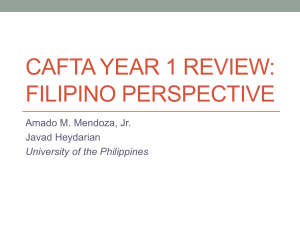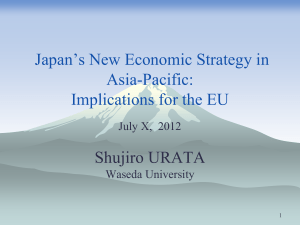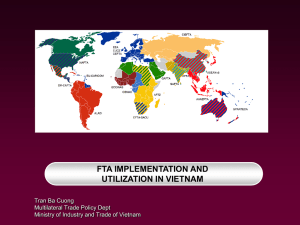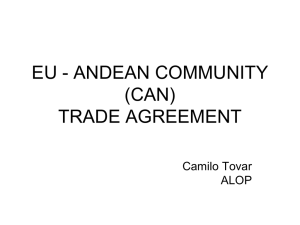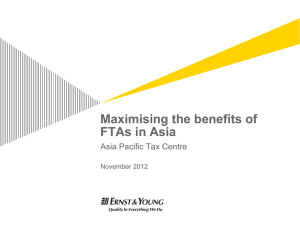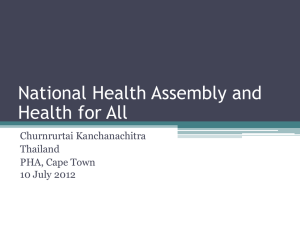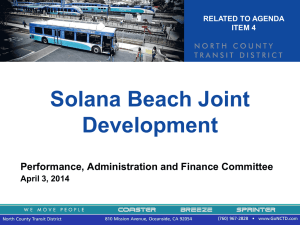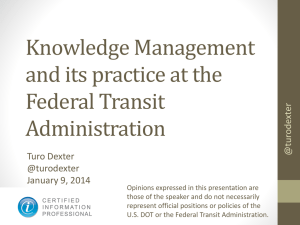ENVIRONMENT AND EAST ASIA
advertisement
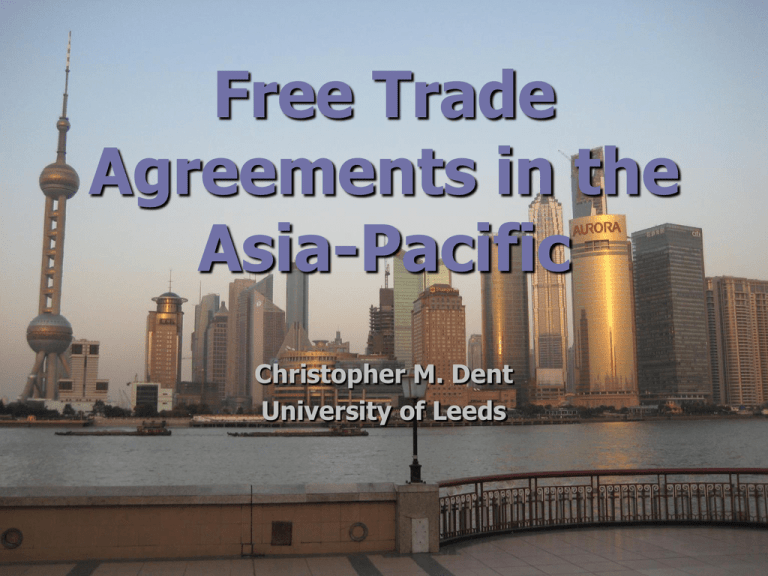
Free Trade Agreements in the Asia-Pacific Christopher M. Dent University of Leeds FTA Activity on the Rise… • Global expansion of FTA activity and regionalism since the early 1990s • Europe and Latin America as early main centres of new FTA activity • East Asia, US and Oceania only start to catch up from the late 1990s onwards • Asia-Pacific witnesses the most intense growth of FTA activity in the world system during the 2000s • FTAs have significantly shaped the AsiaPacific’s international economic relations and business environment… Figure 1.1 Global Map of FTAs by Region (by end of 1997) (4) Europe Central and South Asia East Asia (0) (6) (40) AsiaPacific (7) (8) Pacific America (2) North Africa and Middle East (6) Sub-Saharan Africa Oceania (1) Western Hemisphe re FTAs in region 30+ 21 – 30 11 – 20 0 – 10 (9) FTAs between regions 10+ 5– 9 3– 4 1– 2 (1) (1) Notes 1. Figures relate to FTAs signed under WTO Article XXIV and do not include ‘preferential agreements’ under the WTO’s ‘enabling clause’ for developing countries, or ‘service agreements’ under WTO Article V. 2. Pacific America comprises those Western Hemisphere countries with a Pacific Ocean coastline. Central and South Asia includes the Russia and Asian ex -Soviet republics, as well as the Commonwealth of Independent States FTA. Europe includes the ex -Soviet republics of Belarus, Moldova and Ukraine. 3. Figures include customs unions. By this time, Europe was host to five customs union agreements (European Community, EC – Malta, EC – Cyprus, EC – Andorra and Czech Republic – Slovak Republic) and the EU / EC also had a customs union with Turkey. Similarly, the Western Hemisphere region was host to three customs unions (CACM, CARICOM and MERCOSUR), Central Asia to on e (EAEC), and Sub-Saharan Africa to one (SACU). Source: WTO and author’s own research. Figure 1.10 Global Map of FTAs by Region (by end of 2005) (6) (2) (2) (1) Europe Central and South Asia (43) East Asia (2) AsiaPacific (8) (11) (38*) (16) (8) (4) Pacific America (4) North Africa and Middle East (7) (14) (8) (1) (1) Sub-Saharan Africa Oceania (2) Western Hemisphe re FTAs in region 30+ 21 – 30 11 – 20 0 – 10 (24) FTAs between regions 10+ 5– 9 3– 4 1– 2 (2) Notes 1. Figures relate to FTAs signed under WTO Article XXIV and do not include partial scope agreements under the WTO’s ‘enabling clause’ for developing countries, or ‘service agreements’ under WTO Article V. 2. Pacific America comprises those Western Hemisphere countries with a Pacific Ocean coastline. Central and South Asia includes the Russia and Asian ex -Soviet republics, as well as the Commonwealth of Independent States FTA. Europe includes the ex -Soviet republics of Belarus, Moldova and Ukraine. 3. Figures include customs unions. By this time, Europe was host to four customs union agreements (European Union, EU – Malta, EU – Cyprus and EU – Andorra) and the EU also had a customs union with Turkey. Similarly, the Western Hemisphere region was host to four customs unions (Andean Community, CACM, CARICOM and MERCOSUR), Central Asia to one (EAEC), and Sub-Saharan Africa to one (SACU). * Trans-Pacific Strategic Economic Partnership (TPSEPA) FTA between Singapore, Chile, New Zealand and Brunei counted as additional FTA link. Source: WTO and author’s own research. Figure 6 Asia-Pacific FTA Projects (before 1998) NAFTA Can US Mex - Northern Triangle FTA (ES, Gm, Hd) AFTA Mex Brunei Indonesia Laos Malaysia Myanmar Philippines Singapore Thailand Vietnam Gm Nc CR Pa Pe Ch Aus CER NZ Close r Economic Relationship Aus – Australia Can – Canada Ch – Chile CR – Costa Rica ES – El Salvador Gm – Guatemala Hd – Honduras Mex – Mexico Nc – Nicaragua NZ – Ne w Ze aland Pa – Panama Pe – Pe ru US – Unite d States Proposed Studying Negotiating Concluded / Signed Regional FTA Hd ES CACM Figure 7 Asia-Pacific FTA Projects (by end of 2004) J NAFTA Can K C US Mac HK T Mex - Northern Triangle FTA (ES, Gm, Hd) Mex AFTA CACM Th Gm P Nc CR Ma Ind Pa S* Hd ES CACM Pe Ch* ^ PICTA AFTA Col NZ* Aus CER Close r Economic Relationship Notes: * Pacific-3 FTA negotiating parties, later expanding to quadrilateral Trans-Pacific Strategic Economic Partnership (TPSEPA) arrangement in 2005. ^ PICTA (Pacific Island Countries Trade Agreement) involves the 14 Pacific Island Countries. FTA Phase Development Aus – Australia Br – Brunei C – China Can – Canada Ch – Chile CR – Costa Rica ES – El Salvador Hd - Honduras Gm – Guatemala HK – Hong Ko ng Ind – I ndonesia J – Japan K – South Korea Ma – Malaysia Mac – Macao Mex – Mexico Nc - Nicaragua NZ – New Zealand P – Philippines Pa – Panama Pe – Peru S – Singapore T – Taiwan Th – Thailand US – United States Proposed Studying Negotiating Concluded / Signed Regional FTA Figure 8 Asia-Pacific FTA Projects (by end of 2008) J NAFTA Can K C US^ Mac HK T Mex - Northern Triangle FTA (ES, Gm, Hd) Mex AFTA CACM Gm Th P Nc CR Ma Hd ES CACM Ind Pa S*^ Vn Pe ^ Br*^ Ch*^ PICTA AFTA Col Aus ^ NZ*^ CER Close r Economic Relationship Notes: * Pacific-3 FTA expands to quadrilateral Trans-Pacific Strategic Economic Partnership (TPSEPA) project including Brunei as full negotiating partner from April 2005. ^ TPSEPA then expands to Trans-Pacific Partnership Agreement (TPP) involving Australia, Peru and the United States in negotiations from March 2009. PICTA (Pacific Island Countries Trade Agreement) involves the 14 Pacific Island Countries. Aus – Australia Br – Brunei C – China Can – Canada Ch – Chile Col – Columbia CR – Costa Rica ES – El Salvador Hd - Honduras Gm – Guatemala HK – Hong Ko ng Ind – I ndonesia J – Japan K – South Korea Ma – Malaysia Mac – Macao Mex – Mexico Nc - Nicaragua NZ – New Zealand P – Philippines Pa – Panama Pe – Peru S – Singapore T – Taiwan Th – Thailand US – United States Vn – Vietnam FTA Phase Development Proposed Studying Negotiating Concluded / Signed Regional FTA The Evolving Nature of FTAs • Traditionally, FTAs have primarily entailed the • • elimination of conventional trade barriers (e.g. tariffs) between signatory parties Have been around for a while. Last great spurts of FTA activity were 1860-1914 and the 1930s However, the portrayal of FTAs found in conventional economic textbooks are increasingly outdated… tariffs, etc now as less significant features… more now about commercial regulation and other policy-related measures FTAs are becoming increasingly heterogeneous often ‘stretched’ into wider economic partnership agreements FTA Heterogeneity • Each FTA is crafted in accordance to the political • • • economic interaction between the trade partners concerned Agreements can vary significantly in terms of: scope of commercial liberalisation implementation schedules and modalities commercial regulation provisions, e.g. investment, IPR, government procurement, rules of origin, standards economic co-operation provisions philosophical or ideational approach Dominant trade partners can significantly determine the overall framework and content This is often in accordance to their preferred ‘FTA model’ Key Trends in Asia-Pacific FTA Activity • The large majority of FTAs in the region are • • • • bilateral, consistent with the global trend Notwithstanding FTA heterogeneity, three main FTAs models are evident: US, Japan, China/ASEAN ASEAN as hub for quasi-regional FTAs: with China, Japan, Korea, Aus/NZ, India Plurilateral FTAs: Mexico– Northern Triangle (2000) and TPSEPA (2005, expanding to TPP) Many FTA projects are in effect dormant (e.g. Mexico – Singapore), stalled (e.g. Japan – Korea), or have been abandoned (e.g. US with many SE Asia nations) • Trade partner selection • • • • • The club of ardent free trader nations: NZ, Aus, US, Canada, Singapore, Chile, Panama (Mexico, Korea, Peru as secondary members) Relatively small trade partners often selected ‘Easy’ FTA partner options are running out… In the US, the Obama Administration is far more circumspect than its predecessor about FTAs Japan, China and others are looking more to merge existing FTAs into larger regional arrangements rather than create new FTA partners BUT… large regional FTAs may prove unrealistic As result of the above, FTA activity in the AsiaPacific is slowing down… Existing FTAs may be transformed into different types of agreement, taking on new content, etc Commercial Regulatory Provisions in Asia-Pacific FTAs • FTAs are increasingly focused on commercial • • regulation: the rules and standards that determine the regulatory framework in which the trade and investment related activities of firms take place Core generic areas: investment government procurement intellectual property rights (IPR) competition policy rules of origin (RoO) industrial and other standards Sector-specific areas: financial services, telecoms, etc • Ascendance of commercial regulatory provisions: • • tariffs and other conventional trade barriers have fallen or become less important technological and policy developments: the rise of services trade, open market competition for infrastructure and professional services globalisation and the closer inter-linkage of trade and investment foreign firm penetrability of the host country’s domestic market in terms of business operations as well as product sales FTAs (and hence their rules and regulations) now nominally cover around 40-50% of Asia-Pacific trade US + Aus/NZ focused on regulatory rights, China and ASEAN on regulatory co-operation, Japan, Korea and Singapore a mix of the two FTA Provisions on IPR: Singapore and Thailand FTAs FTA Partner New Zealand Japan Australia EFTA United States Jordan India South Korea TPSEPA Panama China Year FTA Partner Australia New Zealand Japan Year FTA Partner AFTA ACFTA (China) KAFTA (Korea) JACEP (Japan) Year 2001 2002 2003 2003 2004 2005 2005 2006 2006 2006 2008 2004 2004 2008 2002 2004 2007 2008 35 1,089 633 1,589 8,738 24 120 679 128 - 545 96 95 - 427 460 3,231 ASEAN-LEVEL New varieties of plants Regulated products (pharmaceuticals, agrichemicals) Recourse for judicial review and compensation from IPR infringment Partially adopts IPR legislative text and principles of FTA partner Internet domain names Protection of encrypted programme-carrying satellite signals Prevention of IPR-infringing exports Storage of intellectual property in electronic media Protection of undisclosed information Control of anti-competitive practices in contractual licences Layout-designs (topographies) of integrated circuits Patents Industrial designs Geographical indications Trademarks Copyright and related rights Conformance to general principles of IPR Stated compliance to existing WTO (TRIPS) / WIPO agreements on IPR Information exchange and transparency commitments Recourse or reference to WTO (TRIPS) rules only No provisions Word Count in FTA text TRIPs Provision Areas TRIPs-Plus SINGAPORE THAILAND FTA Partner New Zealand Japan Australia EFTA United States Jordan India South Korea TPSEPA Panama China^ FTA Partner Australia New Zealand Japan FTA Partner AFTA / AIA ACFTA (China) KAFTA (Korea) JACEP (Japan) Year 2001 2002 2003 2003 2004 2005 2005 2006 2006 2006 2008 Year 2004 2004 2008 Year 2002 2004 2007 2008 1,306 4,586 3,718 2,088 8,371 4,624 4,653 4,482 - 1,955 - 2,826 3,126 4,567 * Compensation rights clause Investor- state disputes settlement mechanism Taxation exemption Sectoral exemptions and limitations Exceptions on government procurement TRIMS-Plus Exceptions on investor performance requirements Safeguard measures on financial transfers during periods of financial instability Industrial policy assistance awarded exclusively to domestic investors or investments Environmental clause Minimum standard of treatment clause Subrogation clause Prohibition of performance requirements Prohibition of controls on investor international financial transfers Most Favoured Nation (MFN) treatment (in relation to that already afforded to non-Parties) Prohibition of nationalisation or expropriation of assets Prohibition of appointing key personnel (e.g. senior managers) of particular nationality National treatment principle (Article III of GATT) Commitment to future negotiation Stated compliance to existing WTO (TRIMs) agreements on Investment Information exchange and transparency commitments Currently in negotiation No provisions Word Count in main FTA text FTA Provisions on Investment: Singapore and Thailand FTAs TRIMS Provision Areas Protective Clauses and Exceptions SINGAPORE THAILAND ASEAN-Level Notes: Smaller dot denotes a more minor reference to this provision or clause. * MFN treatment applies amongst ASEAN member states only. ^ Obligation to adopt the ACFTA chapter on investment after its concluded negotiation. Sources: Original FTA texts. • Commercial regulation provisions of FTAs can shape • the economic and business environment in various ways… shaping the very nature of international business competition (and ‘free trade’): more defined by regulatory parameters rather than the elimination of conventional trade barriers, e.g. tariffs conferring distinct regulatory preferences, e.g. on govt procurement ‘offer’ thresholds, RoO generally dominant FTA partner shapes the domestic regulatory regime of others, e.g. US and IPR rules of origin and configuration of supply chains and international production networks FTAs extending beyond compliance to WTO accords, e.g. on TRIMS, TRIPS, GPA Approach towards FTA commercial regulation will primarily depend on development capacity factors… Key Points to Conclude… • FTA evolution reflects the fast evolving nature of the global economy and economic relations • FTA growth since end of Cold War, and most rapid growth in the Asia-Pacific, but this growth is slowing • With WTO hampered on global trade liberalisation, FTAs trade and wider commercial regimes will remain very important • FTAs and the idea of ‘freer trade, more regulations?’… the rising prominence of commercial regulation provisions • East Asian nations using FTAs for economic co-operation purposes
